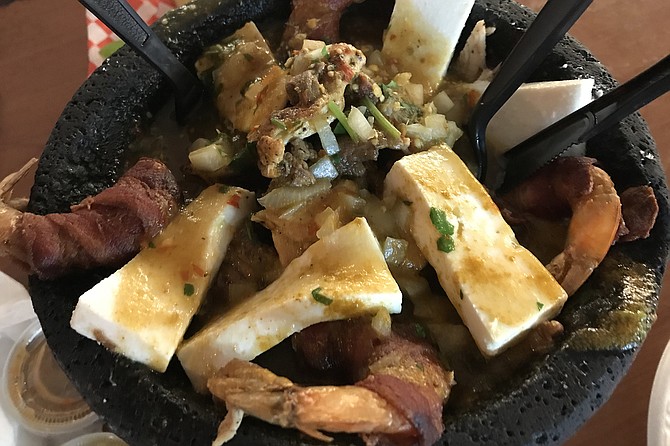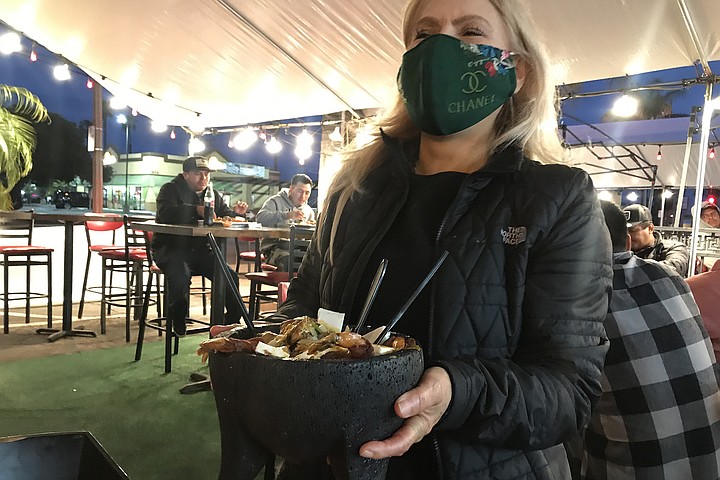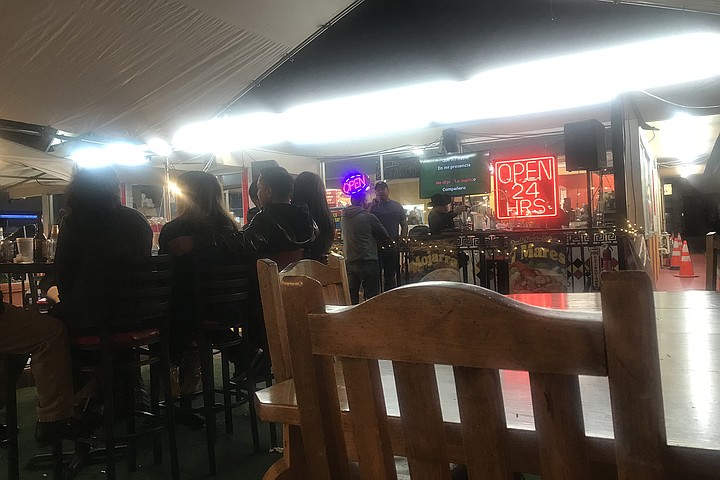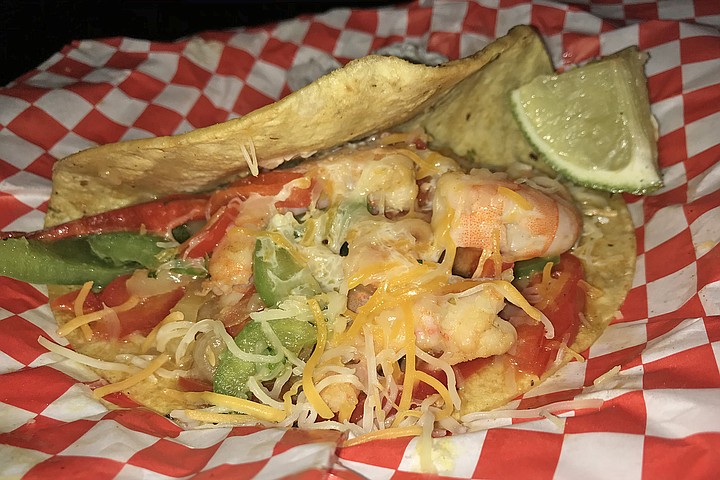 Facebook
Facebook
 X
X
 Instagram
Instagram
 TikTok
TikTok
 Youtube
Youtube

Maggie’s regretting ever opening her mouth. She stands back from where this guy is throwing his into the mic. “You and I are just two leaves in the wind,” he croons. The crowd at his table harmonizes behind him. It’s a Ramon Ayala song, “Las Hojas Sin Rumbo (Swirling Leaves).” Or you might say, “Blowing in the Wind.”
It’s Karaoke night here under the open tents of Sr. Taquito’s on East Valley Parkway in Escondido. Sunday evening, six o’clock.
My step-daughter Mag and I were just talking about food when this scene flashed past. “That’s the place I was talking about!” she says.
Oh wow. For a place with an uninspiring name, it’s got an inspiring atmosphere.
People cluster in groups under the canopies between palms, on red high-top chairs, at tables on shocking green Astroturf. It’s a scene.

Mag ain’t that keen. This is a bit too rural for her. She wants Escondido’s real Old Town section with all the cool restaurants. But for me, this is the real Escondido — it means “Hidden City” — below all those developer rows of houses that ribbon the hills.
Whatever, it’s a bird in hand. We sit down at one of the tables near where the karaoke guy has the music at full volume. And yes, it’s a struggle hearing Marie the waitress shout from behind her mask, specially with gals on their Karaoke mics calling out the chorus just a table over (“Dos hojas sin rumbo, Qué el viento arrastro!”) but she understands my “tipping bottle” sign and Mag’s glass of water sign, and soon gets back with both. Mine’s a Negra Modelo ($5.50), Mag’s, an Agua Fresca ($1.89). Marie also drops off a couple of multi-page, lavishly-illustrated plastic menus.

There’s a lot to choose from. I look down their mini-tacos column, because they start off at $1.89. That’s for an adobada taco. Deal. Ooh. And they have buches. I swear I’ve eaten them at a TJ place called Kentucky Fried Buches, on Avenida Constitución. “Buches” there means “chicken necks.”
Now we’re checking down the menu. Hmm. Once you get specialized, prices go up. Shrimp and octopus cocktail is $16.49, cooked (tostada) shrimp with octopus (enchipotlado, prepared with chipotle chile) with breaded onion, is $15.99. Or a large Del Toro taco with cheese, marlin, shrimp, and octopus goes for $6.49.
Mag and I decide on a $5.95 shrimp taco each, and then, oh man. They have a molcajete mixto dish. You get chicken breast, four “Costa Azul” shrimp, whatever that is, plus meat a la parilla (grilled), with rice, refried beans, and tortillas. No surprise: it costs twenty bucks. “Oh let’s do it,” says Mag. “I can help with cash.”
Turns out she knows quite a bit about molcajetes. “They’re carved out of black volcanic rock. Aztec, Maya design.”

Now she’s googling for more info.
“Huh.‘Molli,’ is ‘seasoning’ or ‘sauce,’ and ‘caxitl’ is ‘bowl.’ And they have been making these things for the past 6000 years.”
First, though, we’re tackling the shrimp tacos. Huge, garlic-luscious, packed with two different cheeses, green and red peppers, and a ton of shrimp flesh. We chomp away as older ladies grab the mics and start belting out tragic love songs, almost in tune, but not on the high notes.
Then, the piece de resistance. Marie carries out this heavy, traditional, pock-marked black lava rock bowl, steaming, sprouting with shrimp, chicken, beef, the whole enchilada. Added bonus: On this chilly night it’s perfect to warm your hands on.
Just as well. The rock keeps our food hot while we take five, to settle the first-round tacos.
But then, what a feast! First off, we find out what they mean by “Costa Azul” shrimp. They are large, deep-fried, and wrapped in bacon. Wicked! Specially dipped in the savory liquid in the bottom. It flavors the chicken, chunks of carne a la parilla beef, the wrapped shrimp, and what turn out to be planks of queso fresco, the curd-like Mexican cheese that doesn’t melt and gives a gentle tang to anything (and fries up to a beautiful golden snack in its own right).
“But what’s in the soup?” I ask Marie.
“A lot,” she says. “We have garlic, chile, cilantro, onions, and tomatillos to give it the sour.”
Whatever, the more we mix and poke, the richer that soup gets. I’m taking spoonfuls of it out, and dunking the corn tortillas in, just for its flavor. They also bring flour tortillas. And still the black rock keeps it warm.
Of course, I don’t stop Marie when she offers to bring another Negra Modelo. Two girls are singing a duet now. I’m really getting into it. The singing somehow gives a togetherness feeling out here in the cold night. Plus, it’s good to spend this time with Mag. We don’t get together enough.
What I like about this place is it has kept its Mexicanness, and doesn’t get lost in the whole fusion food thing. You can see that’s how this crowd wants it to stay that way. Next time, I’m just going to go for the mini-tacos. (They’re really not that mini.) I want to try the slightly more fringey ones like cabeza, lengua, tripa, and buche.
Mag is in no hurry to leave. It’s not the karaoke, which is getting more dodgy as more people find the Dutch courage to grab the mic and yell out the words. It’s that she can’t stop reaching into the bowels of the molcajete to find a few drops more of those ancient flavors.
“Next time, breakfast,” she says finally. “Huevos rancheros would be nice in the morning sun.”
“Uh, do you think they would still be doing karaoke in the morning?” I ask.


Maggie’s regretting ever opening her mouth. She stands back from where this guy is throwing his into the mic. “You and I are just two leaves in the wind,” he croons. The crowd at his table harmonizes behind him. It’s a Ramon Ayala song, “Las Hojas Sin Rumbo (Swirling Leaves).” Or you might say, “Blowing in the Wind.”
It’s Karaoke night here under the open tents of Sr. Taquito’s on East Valley Parkway in Escondido. Sunday evening, six o’clock.
My step-daughter Mag and I were just talking about food when this scene flashed past. “That’s the place I was talking about!” she says.
Oh wow. For a place with an uninspiring name, it’s got an inspiring atmosphere.
People cluster in groups under the canopies between palms, on red high-top chairs, at tables on shocking green Astroturf. It’s a scene.

Mag ain’t that keen. This is a bit too rural for her. She wants Escondido’s real Old Town section with all the cool restaurants. But for me, this is the real Escondido — it means “Hidden City” — below all those developer rows of houses that ribbon the hills.
Whatever, it’s a bird in hand. We sit down at one of the tables near where the karaoke guy has the music at full volume. And yes, it’s a struggle hearing Marie the waitress shout from behind her mask, specially with gals on their Karaoke mics calling out the chorus just a table over (“Dos hojas sin rumbo, Qué el viento arrastro!”) but she understands my “tipping bottle” sign and Mag’s glass of water sign, and soon gets back with both. Mine’s a Negra Modelo ($5.50), Mag’s, an Agua Fresca ($1.89). Marie also drops off a couple of multi-page, lavishly-illustrated plastic menus.

There’s a lot to choose from. I look down their mini-tacos column, because they start off at $1.89. That’s for an adobada taco. Deal. Ooh. And they have buches. I swear I’ve eaten them at a TJ place called Kentucky Fried Buches, on Avenida Constitución. “Buches” there means “chicken necks.”
Now we’re checking down the menu. Hmm. Once you get specialized, prices go up. Shrimp and octopus cocktail is $16.49, cooked (tostada) shrimp with octopus (enchipotlado, prepared with chipotle chile) with breaded onion, is $15.99. Or a large Del Toro taco with cheese, marlin, shrimp, and octopus goes for $6.49.
Mag and I decide on a $5.95 shrimp taco each, and then, oh man. They have a molcajete mixto dish. You get chicken breast, four “Costa Azul” shrimp, whatever that is, plus meat a la parilla (grilled), with rice, refried beans, and tortillas. No surprise: it costs twenty bucks. “Oh let’s do it,” says Mag. “I can help with cash.”
Turns out she knows quite a bit about molcajetes. “They’re carved out of black volcanic rock. Aztec, Maya design.”

Now she’s googling for more info.
“Huh.‘Molli,’ is ‘seasoning’ or ‘sauce,’ and ‘caxitl’ is ‘bowl.’ And they have been making these things for the past 6000 years.”
First, though, we’re tackling the shrimp tacos. Huge, garlic-luscious, packed with two different cheeses, green and red peppers, and a ton of shrimp flesh. We chomp away as older ladies grab the mics and start belting out tragic love songs, almost in tune, but not on the high notes.
Then, the piece de resistance. Marie carries out this heavy, traditional, pock-marked black lava rock bowl, steaming, sprouting with shrimp, chicken, beef, the whole enchilada. Added bonus: On this chilly night it’s perfect to warm your hands on.
Just as well. The rock keeps our food hot while we take five, to settle the first-round tacos.
But then, what a feast! First off, we find out what they mean by “Costa Azul” shrimp. They are large, deep-fried, and wrapped in bacon. Wicked! Specially dipped in the savory liquid in the bottom. It flavors the chicken, chunks of carne a la parilla beef, the wrapped shrimp, and what turn out to be planks of queso fresco, the curd-like Mexican cheese that doesn’t melt and gives a gentle tang to anything (and fries up to a beautiful golden snack in its own right).
“But what’s in the soup?” I ask Marie.
“A lot,” she says. “We have garlic, chile, cilantro, onions, and tomatillos to give it the sour.”
Whatever, the more we mix and poke, the richer that soup gets. I’m taking spoonfuls of it out, and dunking the corn tortillas in, just for its flavor. They also bring flour tortillas. And still the black rock keeps it warm.
Of course, I don’t stop Marie when she offers to bring another Negra Modelo. Two girls are singing a duet now. I’m really getting into it. The singing somehow gives a togetherness feeling out here in the cold night. Plus, it’s good to spend this time with Mag. We don’t get together enough.
What I like about this place is it has kept its Mexicanness, and doesn’t get lost in the whole fusion food thing. You can see that’s how this crowd wants it to stay that way. Next time, I’m just going to go for the mini-tacos. (They’re really not that mini.) I want to try the slightly more fringey ones like cabeza, lengua, tripa, and buche.
Mag is in no hurry to leave. It’s not the karaoke, which is getting more dodgy as more people find the Dutch courage to grab the mic and yell out the words. It’s that she can’t stop reaching into the bowels of the molcajete to find a few drops more of those ancient flavors.
“Next time, breakfast,” she says finally. “Huevos rancheros would be nice in the morning sun.”
“Uh, do you think they would still be doing karaoke in the morning?” I ask.